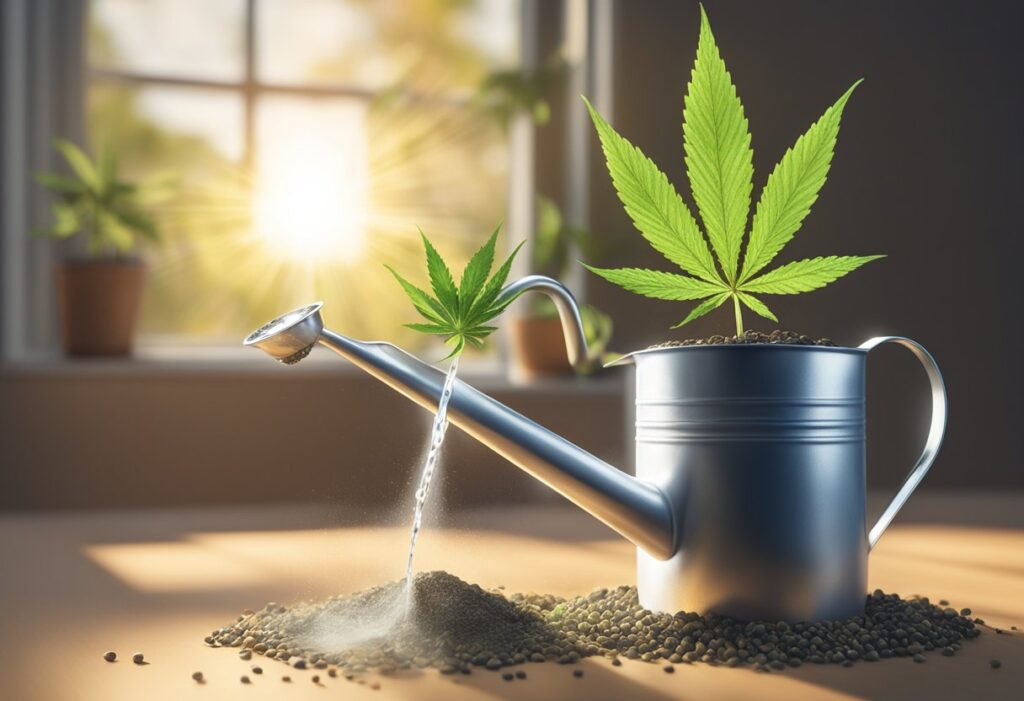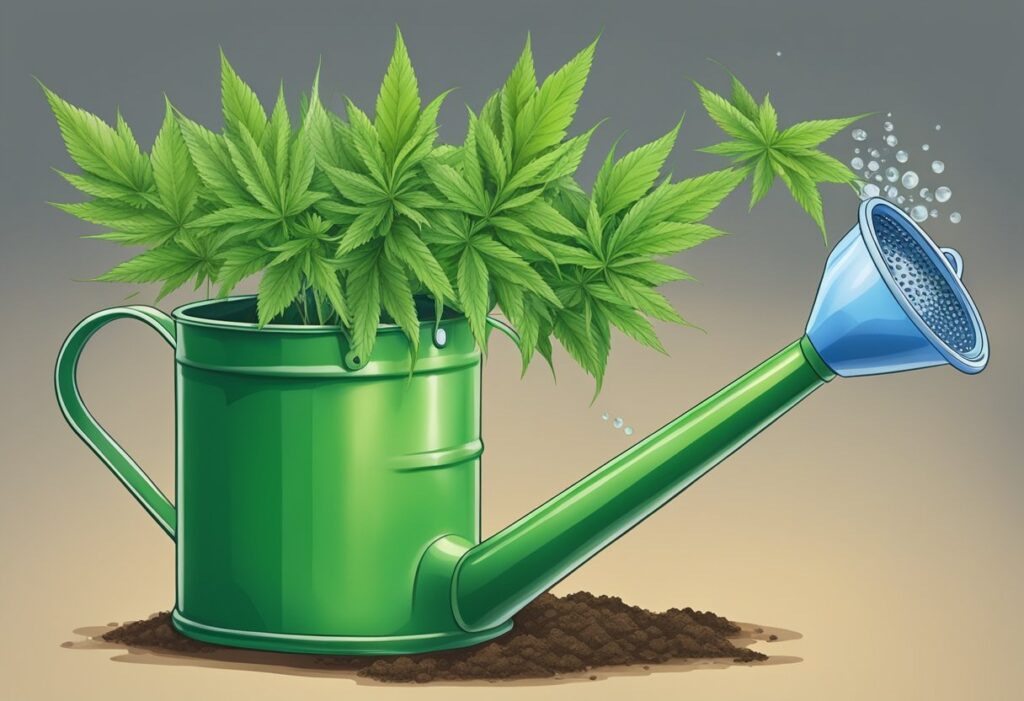
Water is a critical factor in cannabis cultivation, influencing root health, plant growth, and the delicate balance of nutrients within the soil. The right watering practices ensure that cannabis plants thrive, while mistakes in watering can lead to poor plant health and lower yields.
Cannabis plants require water to transport nutrients from the soil to their cells, a key process for healthy growth. The root system acts as the plant’s lifeline, absorbing water and dissolved nutrients. It’s important for the grower to maintain a balance; roots need enough water for nutrient uptake but also sufficient air space to prevent oxygen deprivation. Typically, one should water plants thoroughly to reach the root zone and then allow the growing medium to dry out slightly between watering sessions. This cycle encourages roots to expand in search of moisture, leading to a robust and well-developed root system.
Both overwatering and underwatering can present various symptoms in cannabis plants. Underwatering may cause plants to exhibit drooping, a sign that the turgidity of cells is compromised. Conversely, overwatering can lead to a waterlogged root system, stunting growth and inducing root rot. Signs of excess water include yellowing leaves, a telltale indication of oxygen deficiency and potential nutrient uptake issues. Observing plant behavior is key, as the correct watering frequency varies depending on environmental conditions and the growing stage of the plant.
Water’s interaction with soil and nutrients is a complex affair that requires careful navigation. The pH of the water used can impact the availability of nutrients in the soil. Ideally, water for cannabis should be pH-balanced within the 6.0 to 6.8 range to facilitate optimal nutrient absorption. Misalignment on the pH scale can result in nutrient lockout, leaving the plants unable to access vital minerals and leading to deficiency symptoms. Clean, pH-balanced water aids in preventing imbalances and supports the delivery of nutrients to the plants. Regular monitoring of soil pH and adjusting water pH as needed can greatly enhance nutrient efficiency and plant health.

Effective watering practices are crucial for the health of cannabis plants at each growth stage. This section provides specific techniques to enhance plant vitality through optimal watering strategies.
Water Source: The quality of water used to hydrate cannabis can significantly affect plant health. Growers should use clean, pH-balanced water and consider filtering tap water to remove chlorine and other contaminants that can hinder plant growth. Proper pH levels should range between 6.0 and 7.0 for soil and 5.5 to 6.5 for hydroponic systems.
Water Temperature: For optimal absorption, water temperature should remain consistent at around 20°C (68°F). Extreme temperatures can shock the roots, reducing the plant’s ability to uptake nutrients.
Seedling Stage: Cannabis seedlings require careful and frequent watering due to their undeveloped root systems. Ideally, water them with a light hand to keep the soil consistently moist but not waterlogged.
Vegetative to Flowering Stage: As plants progress from the vegetative to the flowering stage, their water needs increase. It’s essential to let the soil dry out slightly between waterings to encourage strong root development.
| Grow Stage | Quantity |
|---|---|
| Seedling | 2 cups (500ml) every 2-3 days |
| Vegetative | Increase to 3 cups (750ml) as needed |
| Flowering | Adjust based on plant size and environmental conditions |
Drip Irrigation: Establishing a drip irrigation system can enhance watering efficiency by delivering water directly to the root zone. This targeted watering technique reduces waste and helps maintain an ideal moisture level.
Automated Watering Systems: For consistent watering without the guesswork, cannabis cultivators can invest in automated watering systems. These systems can be scheduled to water plants at the best time of day—typically early morning or late evening to minimize evaporation and maximize absorption.

When cultivating marijuana seeds in Canada, ensuring proper watering techniques and environmental control is vital for preventing the onset of diseases and pest infestations that can compromise the health of cannabis plants.
Root Rot: This is a common issue in cannabis cultivation resulting from overwatering. Cannabis plants require a balanced moisture level, as excessive water can lead to a lack of oxygen in the root zone, encouraging the growth of harmful fungi like Pythium. To combat root rot, growers should:
Yellowing Leaves: Often a sign of underwatering or poor nutrient uptake due to damaged roots. Growers must:
Mold and Fungus: High humidity and poor ventilation create ideal conditions for mold, especially in dense foliage. Temperature and humidity should be rigorously controlled to prevent mold growth. Key strategies include:
Pests: Warm, wet environments also invite pests, which can rapidly infest and damage cannabis plants. Preventing pest issues involves:
By following these measures, growers will significantly reduce the risks associated with improper watering, humidity, and temperature regulation, and safeguard their cannabis plants against pests and diseases.
During the initial growth period, marijuana seedlings require consistent moisture but can easily be overwatered. It is critical to water them lightly to keep the soil slightly damp and avoid waterlogging.
In the vegetative stage, one should ensure the plants receive a moderate amount of water. Typically, this means watering them every 2-3 days, depending on factors such as soil type, pot size, and environmental conditions.
Once marijuana plants enter the flowering stage, their water needs can decrease. It’s essential to monitor the soil moisture level closely and reduce the frequency of watering to prevent issues like mold and root rot.
Overwatering can lead to symptoms such as yellowing leaves, wilting, soggy soil, mold growth, and root rot. To avoid it, one should water only when the top inch of the soil is dry and ensure good drainage.
Using a marijuana watering system can offer consistent moisture levels and save time. It’s important to adjust the system to deliver water evenly and at intervals that prevent overwatering.
We ship and deliver world wide via USPS and various couriers.
We offer a wide range of secure and anonymous online payment options.
We care about you, our customer. Please contact us with any questions or concerns.
Find out more about the benefits of being a loyal and regular customer.
WE ARE EVERY GROWERS ONE STOP SHOP TO ACQUIRE PREMIUM CANNABIS SEEDS FOR SALE IN THE USA, CANADA AND AUSTRALIA

Farmers Lab Seeds 2024, | All Right Reserved
Seeds are sold as novelty items, souvenirs, and collectibles. They contain 0% THC. We encourage our customers to check the legislation in their Country, State, Province, and Municipality prior to purchasing items from our store. We do not provide growing information.
All seeds are sold as hemp, and lab tested under 0.3% THC. This product is not for use by or sale to persons under the age of 21. This product should be used only as directed on the label. It should not be used if you are pregnant or nursing. Consult with a physician before use if you have a serious medical condition or use prescription medications. A Doctor’s advice should be sought before using this and any supplemental dietary product. All trademarks and copyrights are property of their respective owners and are not affiliated with nor do they endorse this product.
These statements have not been evaluated by the FDA. This product is not intended to diagnose, treat, cure or prevent any disease. Individual weight loss results will vary. By using this site, you agree to follow the Privacy Policy and all Terms & Conditions printed on this site. Void Where Prohibited by Law.